Project Description Blue Mountains TAFE Name Institution Introduction 3 Project Details 3 Project Team 4 Projects 4 Blue Mountains TAFE Name Institution Introduction 3 Project Details 3 Project Team 4
VerifiedAdded on 2021/05/30
|15
|3870
|204
AI Summary
Project 4Blue Mountains TAFE Name Institution Introduction 3 Project Details 3 Project Team 4 Quality Policy4 Quality Procedure Register5 Client Variation Register and Subcontractor Variation Register5 Cost Control 6 Document Control 6 Drawing Control 8 Site Instruction Register 8 Request for Information Register 9 Inspection and Test Plans 9 Non-conformance Register 11 Program 11 Program Register 11 EOT Notification and Register 12 Internal Procedures 12 Filing System 13 References 14 Project Quality Plan for Project 4Blue Mountains TAFE Introduction The main aim of quality management in construction
Contribute Materials
Your contribution can guide someone’s learning journey. Share your
documents today.
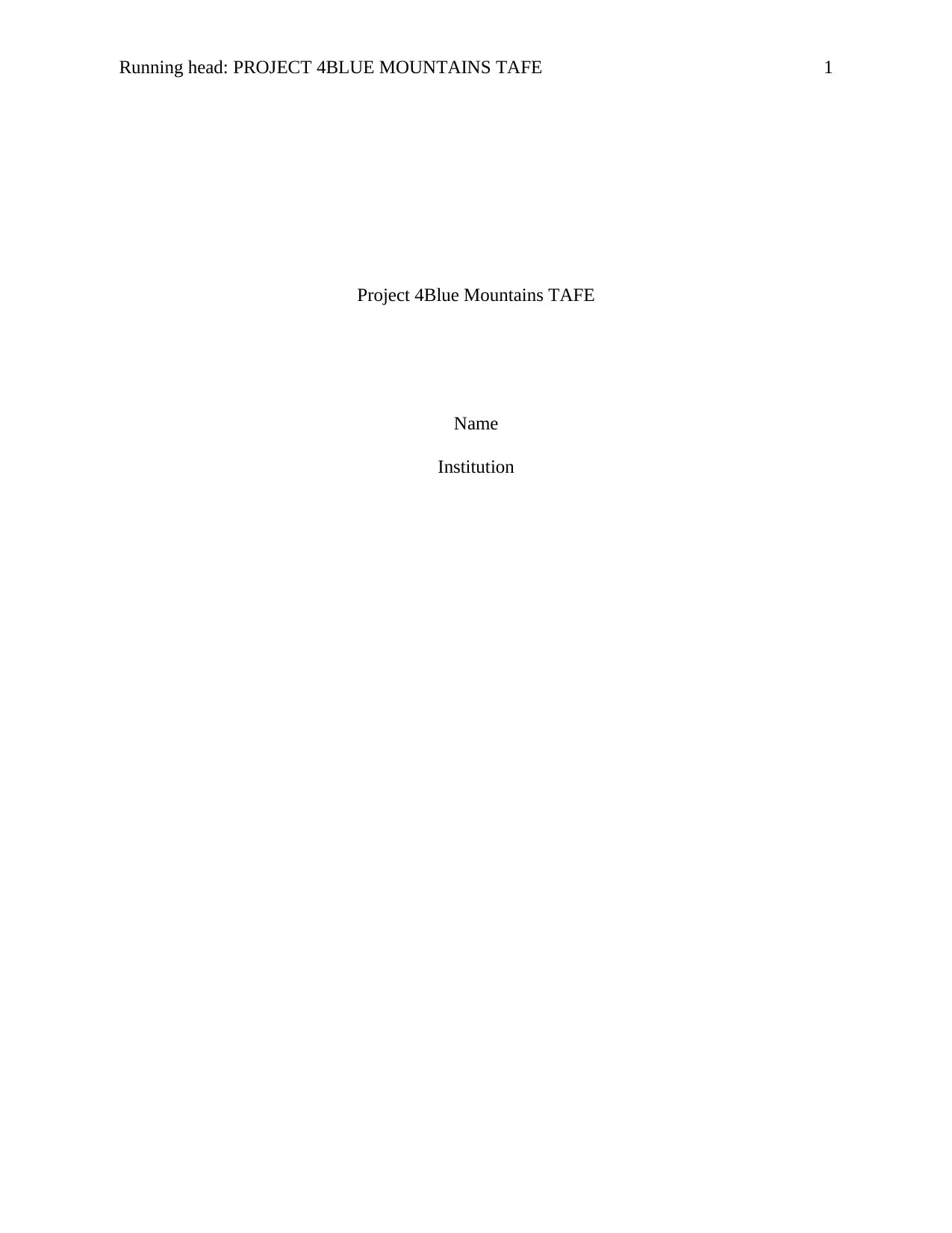
Running head: PROJECT 4BLUE MOUNTAINS TAFE 1
Project 4Blue Mountains TAFE
Name
Institution
Project 4Blue Mountains TAFE
Name
Institution
Secure Best Marks with AI Grader
Need help grading? Try our AI Grader for instant feedback on your assignments.
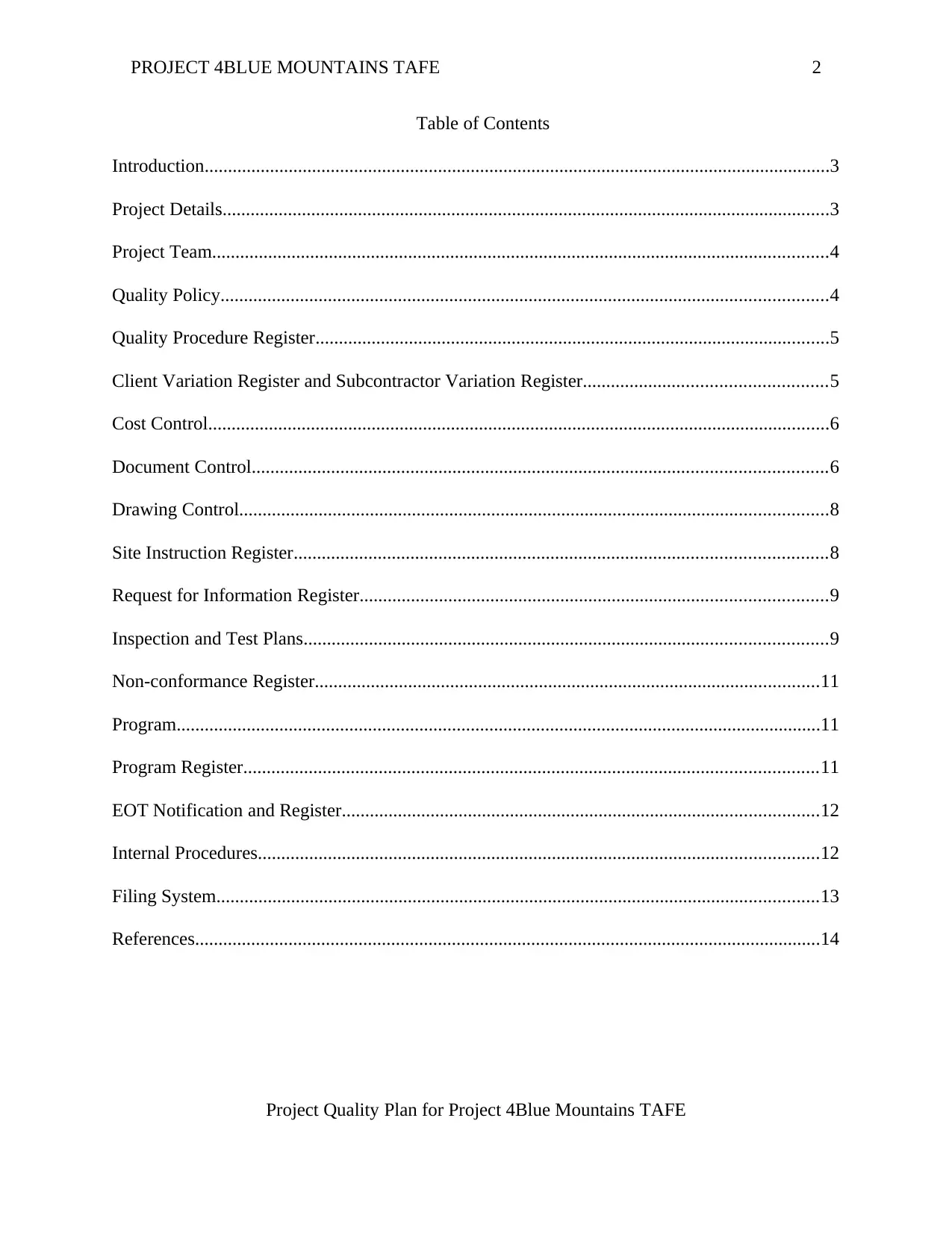
PROJECT 4BLUE MOUNTAINS TAFE 2
Table of Contents
Introduction......................................................................................................................................3
Project Details..................................................................................................................................3
Project Team....................................................................................................................................4
Quality Policy..................................................................................................................................4
Quality Procedure Register..............................................................................................................5
Client Variation Register and Subcontractor Variation Register....................................................5
Cost Control.....................................................................................................................................6
Document Control...........................................................................................................................6
Drawing Control..............................................................................................................................8
Site Instruction Register..................................................................................................................8
Request for Information Register....................................................................................................9
Inspection and Test Plans................................................................................................................9
Non-conformance Register............................................................................................................11
Program..........................................................................................................................................11
Program Register...........................................................................................................................11
EOT Notification and Register......................................................................................................12
Internal Procedures........................................................................................................................12
Filing System.................................................................................................................................13
References......................................................................................................................................14
Project Quality Plan for Project 4Blue Mountains TAFE
Table of Contents
Introduction......................................................................................................................................3
Project Details..................................................................................................................................3
Project Team....................................................................................................................................4
Quality Policy..................................................................................................................................4
Quality Procedure Register..............................................................................................................5
Client Variation Register and Subcontractor Variation Register....................................................5
Cost Control.....................................................................................................................................6
Document Control...........................................................................................................................6
Drawing Control..............................................................................................................................8
Site Instruction Register..................................................................................................................8
Request for Information Register....................................................................................................9
Inspection and Test Plans................................................................................................................9
Non-conformance Register............................................................................................................11
Program..........................................................................................................................................11
Program Register...........................................................................................................................11
EOT Notification and Register......................................................................................................12
Internal Procedures........................................................................................................................12
Filing System.................................................................................................................................13
References......................................................................................................................................14
Project Quality Plan for Project 4Blue Mountains TAFE
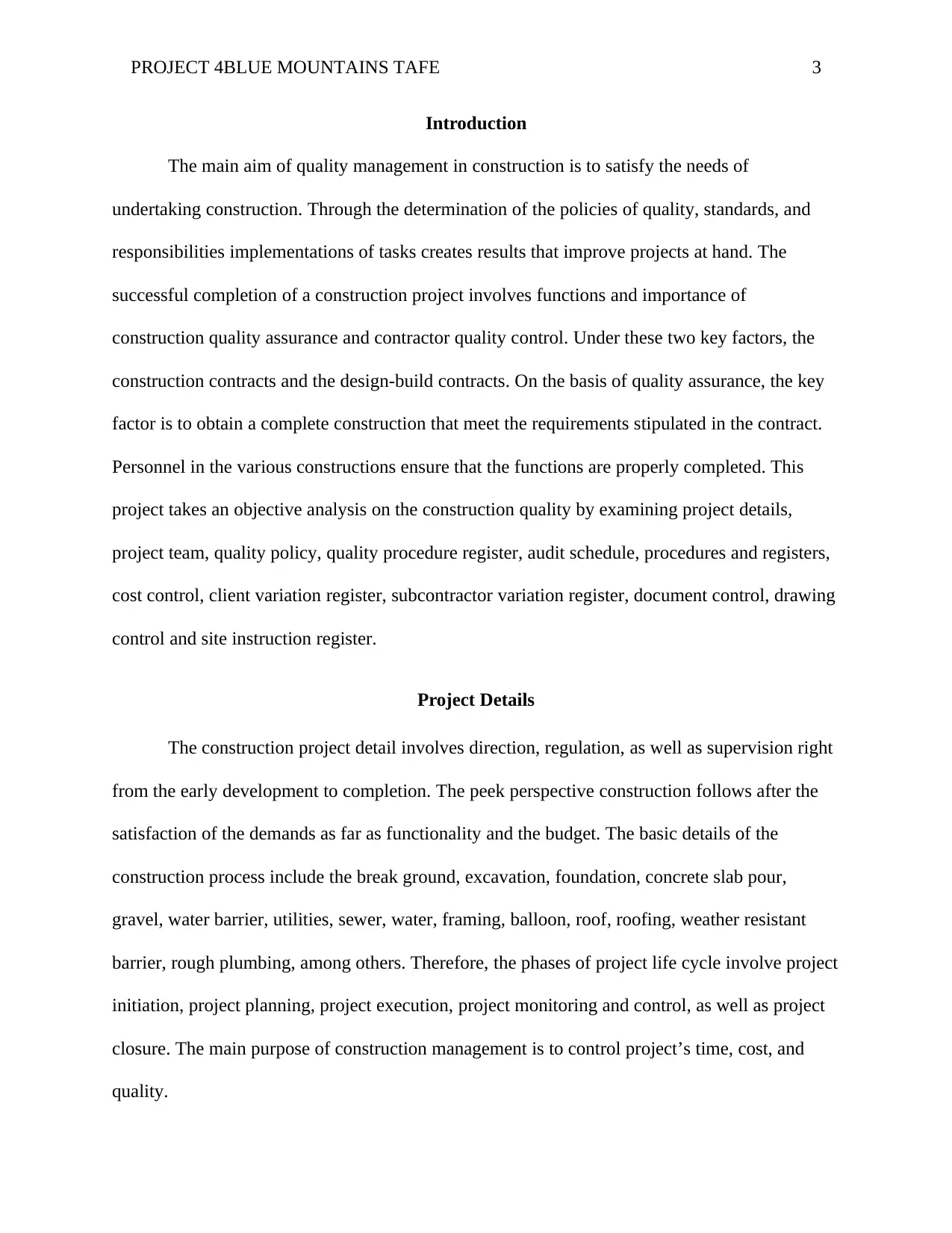
PROJECT 4BLUE MOUNTAINS TAFE 3
Introduction
The main aim of quality management in construction is to satisfy the needs of
undertaking construction. Through the determination of the policies of quality, standards, and
responsibilities implementations of tasks creates results that improve projects at hand. The
successful completion of a construction project involves functions and importance of
construction quality assurance and contractor quality control. Under these two key factors, the
construction contracts and the design-build contracts. On the basis of quality assurance, the key
factor is to obtain a complete construction that meet the requirements stipulated in the contract.
Personnel in the various constructions ensure that the functions are properly completed. This
project takes an objective analysis on the construction quality by examining project details,
project team, quality policy, quality procedure register, audit schedule, procedures and registers,
cost control, client variation register, subcontractor variation register, document control, drawing
control and site instruction register.
Project Details
The construction project detail involves direction, regulation, as well as supervision right
from the early development to completion. The peek perspective construction follows after the
satisfaction of the demands as far as functionality and the budget. The basic details of the
construction process include the break ground, excavation, foundation, concrete slab pour,
gravel, water barrier, utilities, sewer, water, framing, balloon, roof, roofing, weather resistant
barrier, rough plumbing, among others. Therefore, the phases of project life cycle involve project
initiation, project planning, project execution, project monitoring and control, as well as project
closure. The main purpose of construction management is to control project’s time, cost, and
quality.
Introduction
The main aim of quality management in construction is to satisfy the needs of
undertaking construction. Through the determination of the policies of quality, standards, and
responsibilities implementations of tasks creates results that improve projects at hand. The
successful completion of a construction project involves functions and importance of
construction quality assurance and contractor quality control. Under these two key factors, the
construction contracts and the design-build contracts. On the basis of quality assurance, the key
factor is to obtain a complete construction that meet the requirements stipulated in the contract.
Personnel in the various constructions ensure that the functions are properly completed. This
project takes an objective analysis on the construction quality by examining project details,
project team, quality policy, quality procedure register, audit schedule, procedures and registers,
cost control, client variation register, subcontractor variation register, document control, drawing
control and site instruction register.
Project Details
The construction project detail involves direction, regulation, as well as supervision right
from the early development to completion. The peek perspective construction follows after the
satisfaction of the demands as far as functionality and the budget. The basic details of the
construction process include the break ground, excavation, foundation, concrete slab pour,
gravel, water barrier, utilities, sewer, water, framing, balloon, roof, roofing, weather resistant
barrier, rough plumbing, among others. Therefore, the phases of project life cycle involve project
initiation, project planning, project execution, project monitoring and control, as well as project
closure. The main purpose of construction management is to control project’s time, cost, and
quality.
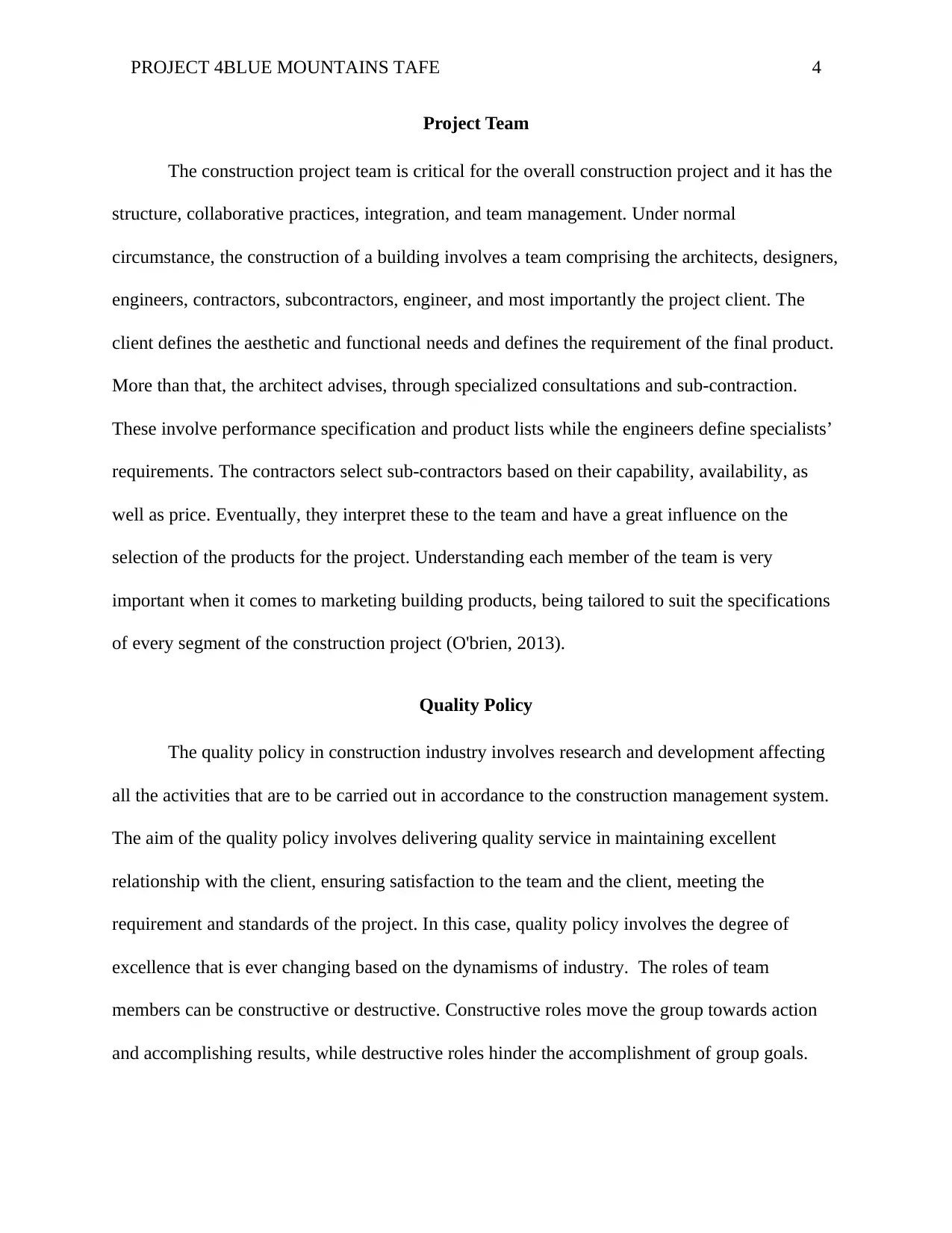
PROJECT 4BLUE MOUNTAINS TAFE 4
Project Team
The construction project team is critical for the overall construction project and it has the
structure, collaborative practices, integration, and team management. Under normal
circumstance, the construction of a building involves a team comprising the architects, designers,
engineers, contractors, subcontractors, engineer, and most importantly the project client. The
client defines the aesthetic and functional needs and defines the requirement of the final product.
More than that, the architect advises, through specialized consultations and sub-contraction.
These involve performance specification and product lists while the engineers define specialists’
requirements. The contractors select sub-contractors based on their capability, availability, as
well as price. Eventually, they interpret these to the team and have a great influence on the
selection of the products for the project. Understanding each member of the team is very
important when it comes to marketing building products, being tailored to suit the specifications
of every segment of the construction project (O'brien, 2013).
Quality Policy
The quality policy in construction industry involves research and development affecting
all the activities that are to be carried out in accordance to the construction management system.
The aim of the quality policy involves delivering quality service in maintaining excellent
relationship with the client, ensuring satisfaction to the team and the client, meeting the
requirement and standards of the project. In this case, quality policy involves the degree of
excellence that is ever changing based on the dynamisms of industry. The roles of team
members can be constructive or destructive. Constructive roles move the group towards action
and accomplishing results, while destructive roles hinder the accomplishment of group goals.
Project Team
The construction project team is critical for the overall construction project and it has the
structure, collaborative practices, integration, and team management. Under normal
circumstance, the construction of a building involves a team comprising the architects, designers,
engineers, contractors, subcontractors, engineer, and most importantly the project client. The
client defines the aesthetic and functional needs and defines the requirement of the final product.
More than that, the architect advises, through specialized consultations and sub-contraction.
These involve performance specification and product lists while the engineers define specialists’
requirements. The contractors select sub-contractors based on their capability, availability, as
well as price. Eventually, they interpret these to the team and have a great influence on the
selection of the products for the project. Understanding each member of the team is very
important when it comes to marketing building products, being tailored to suit the specifications
of every segment of the construction project (O'brien, 2013).
Quality Policy
The quality policy in construction industry involves research and development affecting
all the activities that are to be carried out in accordance to the construction management system.
The aim of the quality policy involves delivering quality service in maintaining excellent
relationship with the client, ensuring satisfaction to the team and the client, meeting the
requirement and standards of the project. In this case, quality policy involves the degree of
excellence that is ever changing based on the dynamisms of industry. The roles of team
members can be constructive or destructive. Constructive roles move the group towards action
and accomplishing results, while destructive roles hinder the accomplishment of group goals.
Secure Best Marks with AI Grader
Need help grading? Try our AI Grader for instant feedback on your assignments.
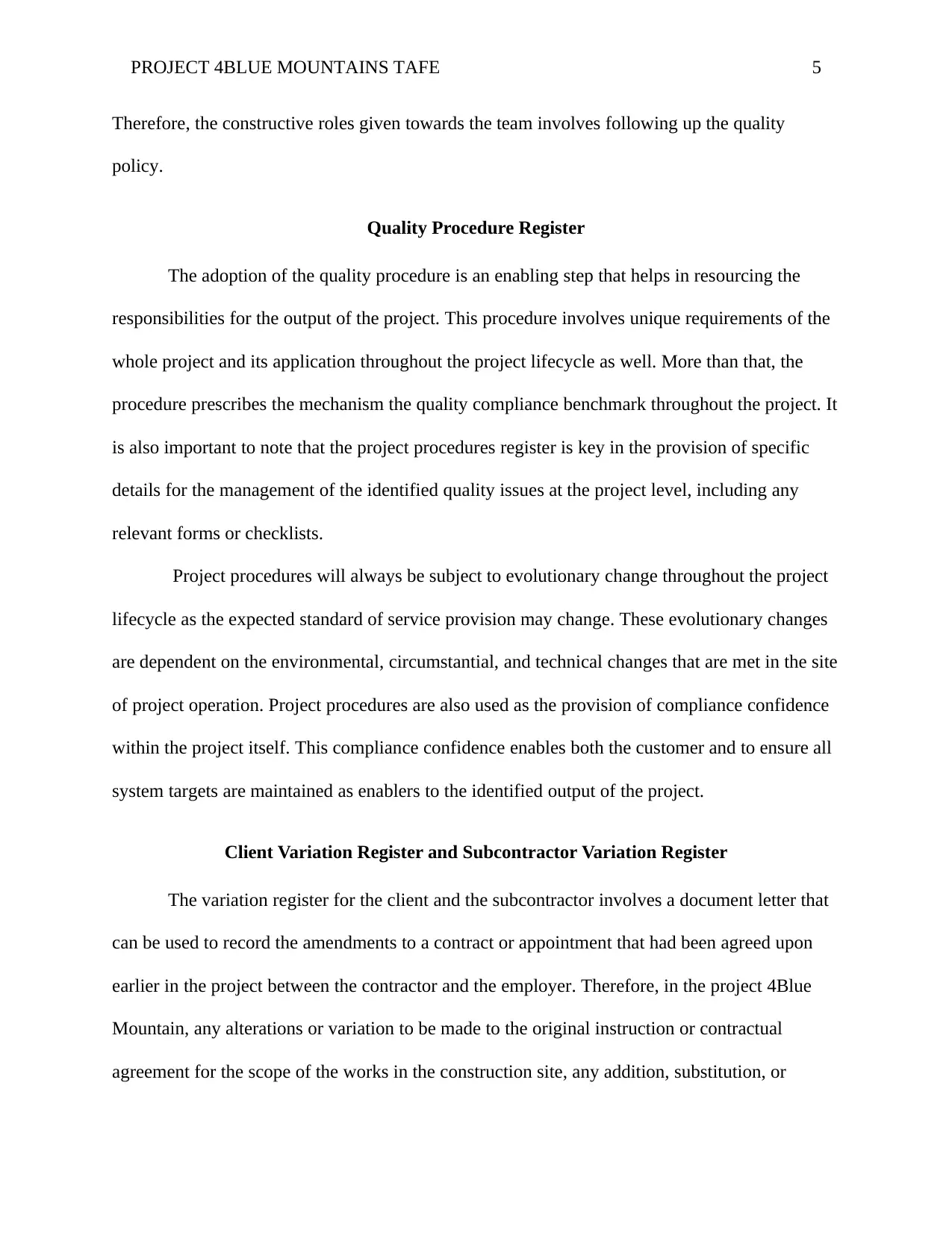
PROJECT 4BLUE MOUNTAINS TAFE 5
Therefore, the constructive roles given towards the team involves following up the quality
policy.
Quality Procedure Register
The adoption of the quality procedure is an enabling step that helps in resourcing the
responsibilities for the output of the project. This procedure involves unique requirements of the
whole project and its application throughout the project lifecycle as well. More than that, the
procedure prescribes the mechanism the quality compliance benchmark throughout the project. It
is also important to note that the project procedures register is key in the provision of specific
details for the management of the identified quality issues at the project level, including any
relevant forms or checklists.
Project procedures will always be subject to evolutionary change throughout the project
lifecycle as the expected standard of service provision may change. These evolutionary changes
are dependent on the environmental, circumstantial, and technical changes that are met in the site
of project operation. Project procedures are also used as the provision of compliance confidence
within the project itself. This compliance confidence enables both the customer and to ensure all
system targets are maintained as enablers to the identified output of the project.
Client Variation Register and Subcontractor Variation Register
The variation register for the client and the subcontractor involves a document letter that
can be used to record the amendments to a contract or appointment that had been agreed upon
earlier in the project between the contractor and the employer. Therefore, in the project 4Blue
Mountain, any alterations or variation to be made to the original instruction or contractual
agreement for the scope of the works in the construction site, any addition, substitution, or
Therefore, the constructive roles given towards the team involves following up the quality
policy.
Quality Procedure Register
The adoption of the quality procedure is an enabling step that helps in resourcing the
responsibilities for the output of the project. This procedure involves unique requirements of the
whole project and its application throughout the project lifecycle as well. More than that, the
procedure prescribes the mechanism the quality compliance benchmark throughout the project. It
is also important to note that the project procedures register is key in the provision of specific
details for the management of the identified quality issues at the project level, including any
relevant forms or checklists.
Project procedures will always be subject to evolutionary change throughout the project
lifecycle as the expected standard of service provision may change. These evolutionary changes
are dependent on the environmental, circumstantial, and technical changes that are met in the site
of project operation. Project procedures are also used as the provision of compliance confidence
within the project itself. This compliance confidence enables both the customer and to ensure all
system targets are maintained as enablers to the identified output of the project.
Client Variation Register and Subcontractor Variation Register
The variation register for the client and the subcontractor involves a document letter that
can be used to record the amendments to a contract or appointment that had been agreed upon
earlier in the project between the contractor and the employer. Therefore, in the project 4Blue
Mountain, any alterations or variation to be made to the original instruction or contractual
agreement for the scope of the works in the construction site, any addition, substitution, or
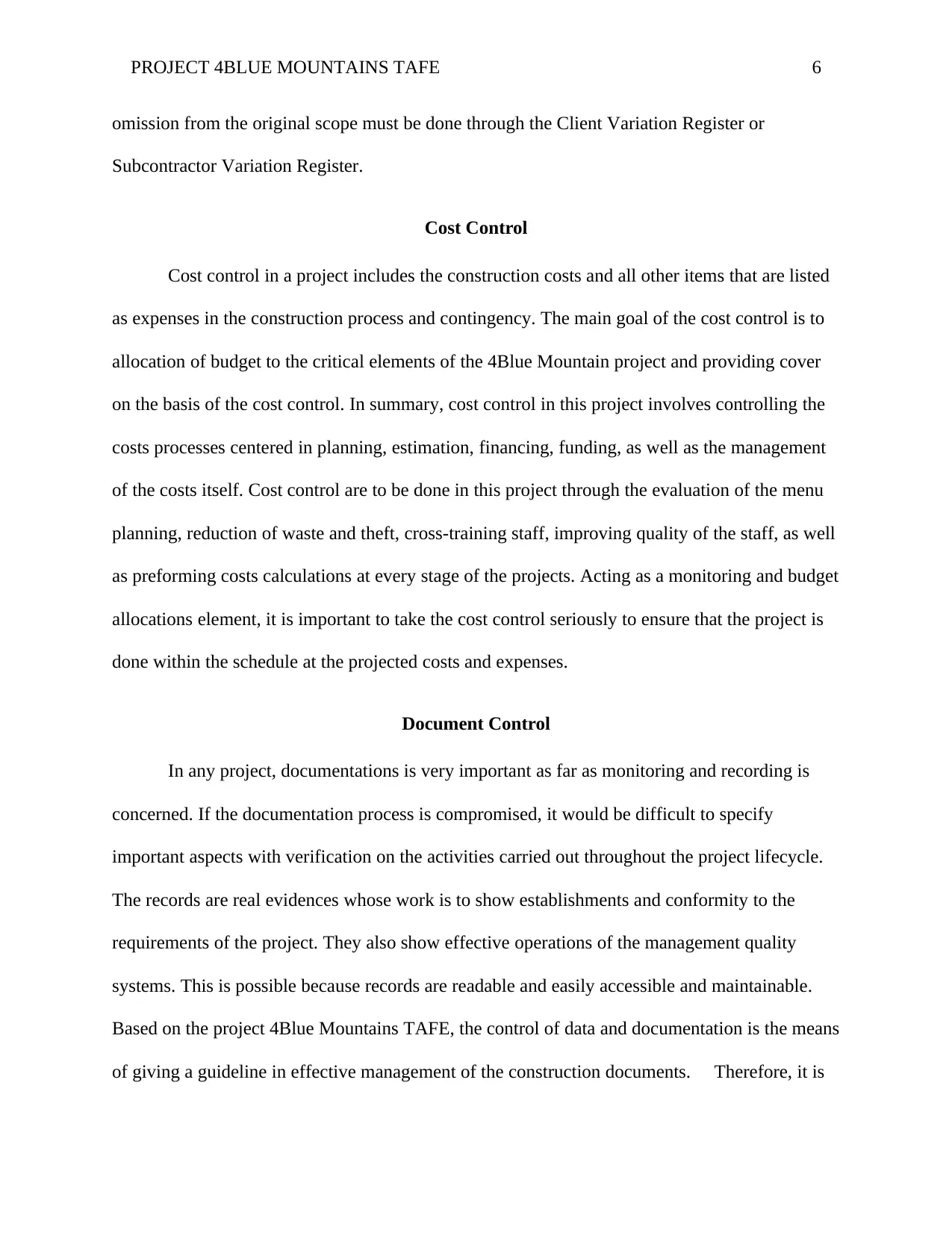
PROJECT 4BLUE MOUNTAINS TAFE 6
omission from the original scope must be done through the Client Variation Register or
Subcontractor Variation Register.
Cost Control
Cost control in a project includes the construction costs and all other items that are listed
as expenses in the construction process and contingency. The main goal of the cost control is to
allocation of budget to the critical elements of the 4Blue Mountain project and providing cover
on the basis of the cost control. In summary, cost control in this project involves controlling the
costs processes centered in planning, estimation, financing, funding, as well as the management
of the costs itself. Cost control are to be done in this project through the evaluation of the menu
planning, reduction of waste and theft, cross-training staff, improving quality of the staff, as well
as preforming costs calculations at every stage of the projects. Acting as a monitoring and budget
allocations element, it is important to take the cost control seriously to ensure that the project is
done within the schedule at the projected costs and expenses.
Document Control
In any project, documentations is very important as far as monitoring and recording is
concerned. If the documentation process is compromised, it would be difficult to specify
important aspects with verification on the activities carried out throughout the project lifecycle.
The records are real evidences whose work is to show establishments and conformity to the
requirements of the project. They also show effective operations of the management quality
systems. This is possible because records are readable and easily accessible and maintainable.
Based on the project 4Blue Mountains TAFE, the control of data and documentation is the means
of giving a guideline in effective management of the construction documents. Therefore, it is
omission from the original scope must be done through the Client Variation Register or
Subcontractor Variation Register.
Cost Control
Cost control in a project includes the construction costs and all other items that are listed
as expenses in the construction process and contingency. The main goal of the cost control is to
allocation of budget to the critical elements of the 4Blue Mountain project and providing cover
on the basis of the cost control. In summary, cost control in this project involves controlling the
costs processes centered in planning, estimation, financing, funding, as well as the management
of the costs itself. Cost control are to be done in this project through the evaluation of the menu
planning, reduction of waste and theft, cross-training staff, improving quality of the staff, as well
as preforming costs calculations at every stage of the projects. Acting as a monitoring and budget
allocations element, it is important to take the cost control seriously to ensure that the project is
done within the schedule at the projected costs and expenses.
Document Control
In any project, documentations is very important as far as monitoring and recording is
concerned. If the documentation process is compromised, it would be difficult to specify
important aspects with verification on the activities carried out throughout the project lifecycle.
The records are real evidences whose work is to show establishments and conformity to the
requirements of the project. They also show effective operations of the management quality
systems. This is possible because records are readable and easily accessible and maintainable.
Based on the project 4Blue Mountains TAFE, the control of data and documentation is the means
of giving a guideline in effective management of the construction documents. Therefore, it is
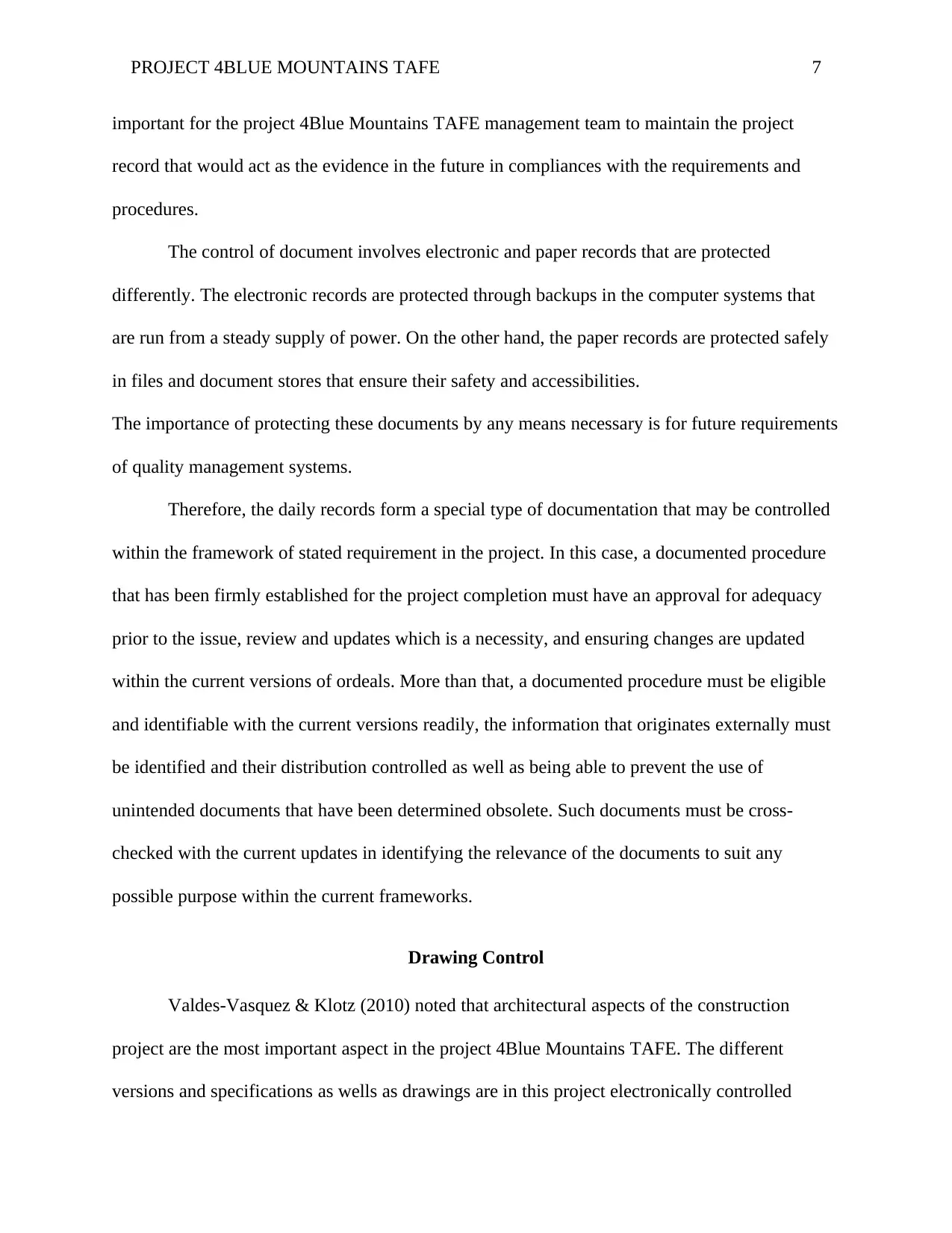
PROJECT 4BLUE MOUNTAINS TAFE 7
important for the project 4Blue Mountains TAFE management team to maintain the project
record that would act as the evidence in the future in compliances with the requirements and
procedures.
The control of document involves electronic and paper records that are protected
differently. The electronic records are protected through backups in the computer systems that
are run from a steady supply of power. On the other hand, the paper records are protected safely
in files and document stores that ensure their safety and accessibilities.
The importance of protecting these documents by any means necessary is for future requirements
of quality management systems.
Therefore, the daily records form a special type of documentation that may be controlled
within the framework of stated requirement in the project. In this case, a documented procedure
that has been firmly established for the project completion must have an approval for adequacy
prior to the issue, review and updates which is a necessity, and ensuring changes are updated
within the current versions of ordeals. More than that, a documented procedure must be eligible
and identifiable with the current versions readily, the information that originates externally must
be identified and their distribution controlled as well as being able to prevent the use of
unintended documents that have been determined obsolete. Such documents must be cross-
checked with the current updates in identifying the relevance of the documents to suit any
possible purpose within the current frameworks.
Drawing Control
Valdes-Vasquez & Klotz (2010) noted that architectural aspects of the construction
project are the most important aspect in the project 4Blue Mountains TAFE. The different
versions and specifications as wells as drawings are in this project electronically controlled
important for the project 4Blue Mountains TAFE management team to maintain the project
record that would act as the evidence in the future in compliances with the requirements and
procedures.
The control of document involves electronic and paper records that are protected
differently. The electronic records are protected through backups in the computer systems that
are run from a steady supply of power. On the other hand, the paper records are protected safely
in files and document stores that ensure their safety and accessibilities.
The importance of protecting these documents by any means necessary is for future requirements
of quality management systems.
Therefore, the daily records form a special type of documentation that may be controlled
within the framework of stated requirement in the project. In this case, a documented procedure
that has been firmly established for the project completion must have an approval for adequacy
prior to the issue, review and updates which is a necessity, and ensuring changes are updated
within the current versions of ordeals. More than that, a documented procedure must be eligible
and identifiable with the current versions readily, the information that originates externally must
be identified and their distribution controlled as well as being able to prevent the use of
unintended documents that have been determined obsolete. Such documents must be cross-
checked with the current updates in identifying the relevance of the documents to suit any
possible purpose within the current frameworks.
Drawing Control
Valdes-Vasquez & Klotz (2010) noted that architectural aspects of the construction
project are the most important aspect in the project 4Blue Mountains TAFE. The different
versions and specifications as wells as drawings are in this project electronically controlled
Paraphrase This Document
Need a fresh take? Get an instant paraphrase of this document with our AI Paraphraser
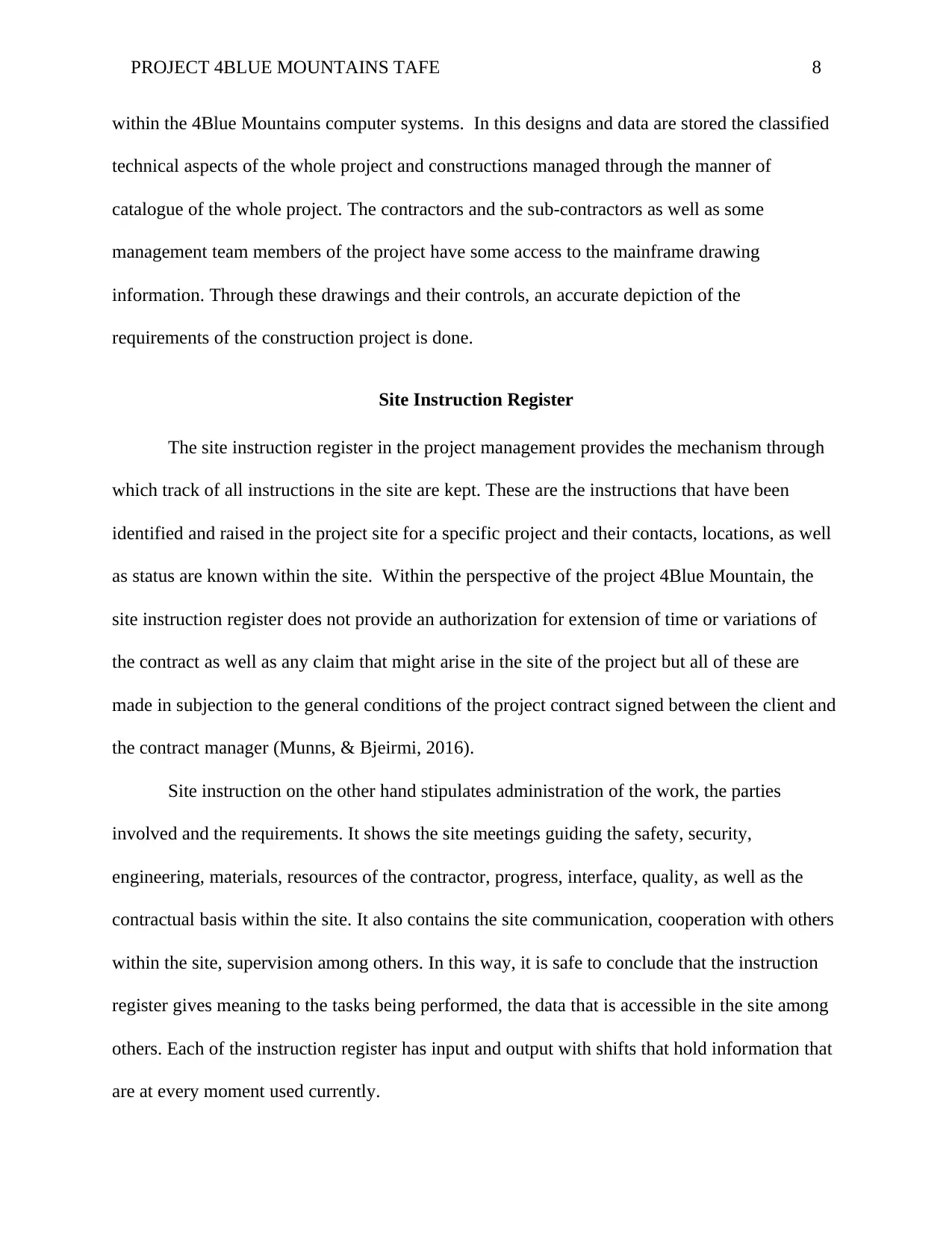
PROJECT 4BLUE MOUNTAINS TAFE 8
within the 4Blue Mountains computer systems. In this designs and data are stored the classified
technical aspects of the whole project and constructions managed through the manner of
catalogue of the whole project. The contractors and the sub-contractors as well as some
management team members of the project have some access to the mainframe drawing
information. Through these drawings and their controls, an accurate depiction of the
requirements of the construction project is done.
Site Instruction Register
The site instruction register in the project management provides the mechanism through
which track of all instructions in the site are kept. These are the instructions that have been
identified and raised in the project site for a specific project and their contacts, locations, as well
as status are known within the site. Within the perspective of the project 4Blue Mountain, the
site instruction register does not provide an authorization for extension of time or variations of
the contract as well as any claim that might arise in the site of the project but all of these are
made in subjection to the general conditions of the project contract signed between the client and
the contract manager (Munns, & Bjeirmi, 2016).
Site instruction on the other hand stipulates administration of the work, the parties
involved and the requirements. It shows the site meetings guiding the safety, security,
engineering, materials, resources of the contractor, progress, interface, quality, as well as the
contractual basis within the site. It also contains the site communication, cooperation with others
within the site, supervision among others. In this way, it is safe to conclude that the instruction
register gives meaning to the tasks being performed, the data that is accessible in the site among
others. Each of the instruction register has input and output with shifts that hold information that
are at every moment used currently.
within the 4Blue Mountains computer systems. In this designs and data are stored the classified
technical aspects of the whole project and constructions managed through the manner of
catalogue of the whole project. The contractors and the sub-contractors as well as some
management team members of the project have some access to the mainframe drawing
information. Through these drawings and their controls, an accurate depiction of the
requirements of the construction project is done.
Site Instruction Register
The site instruction register in the project management provides the mechanism through
which track of all instructions in the site are kept. These are the instructions that have been
identified and raised in the project site for a specific project and their contacts, locations, as well
as status are known within the site. Within the perspective of the project 4Blue Mountain, the
site instruction register does not provide an authorization for extension of time or variations of
the contract as well as any claim that might arise in the site of the project but all of these are
made in subjection to the general conditions of the project contract signed between the client and
the contract manager (Munns, & Bjeirmi, 2016).
Site instruction on the other hand stipulates administration of the work, the parties
involved and the requirements. It shows the site meetings guiding the safety, security,
engineering, materials, resources of the contractor, progress, interface, quality, as well as the
contractual basis within the site. It also contains the site communication, cooperation with others
within the site, supervision among others. In this way, it is safe to conclude that the instruction
register gives meaning to the tasks being performed, the data that is accessible in the site among
others. Each of the instruction register has input and output with shifts that hold information that
are at every moment used currently.
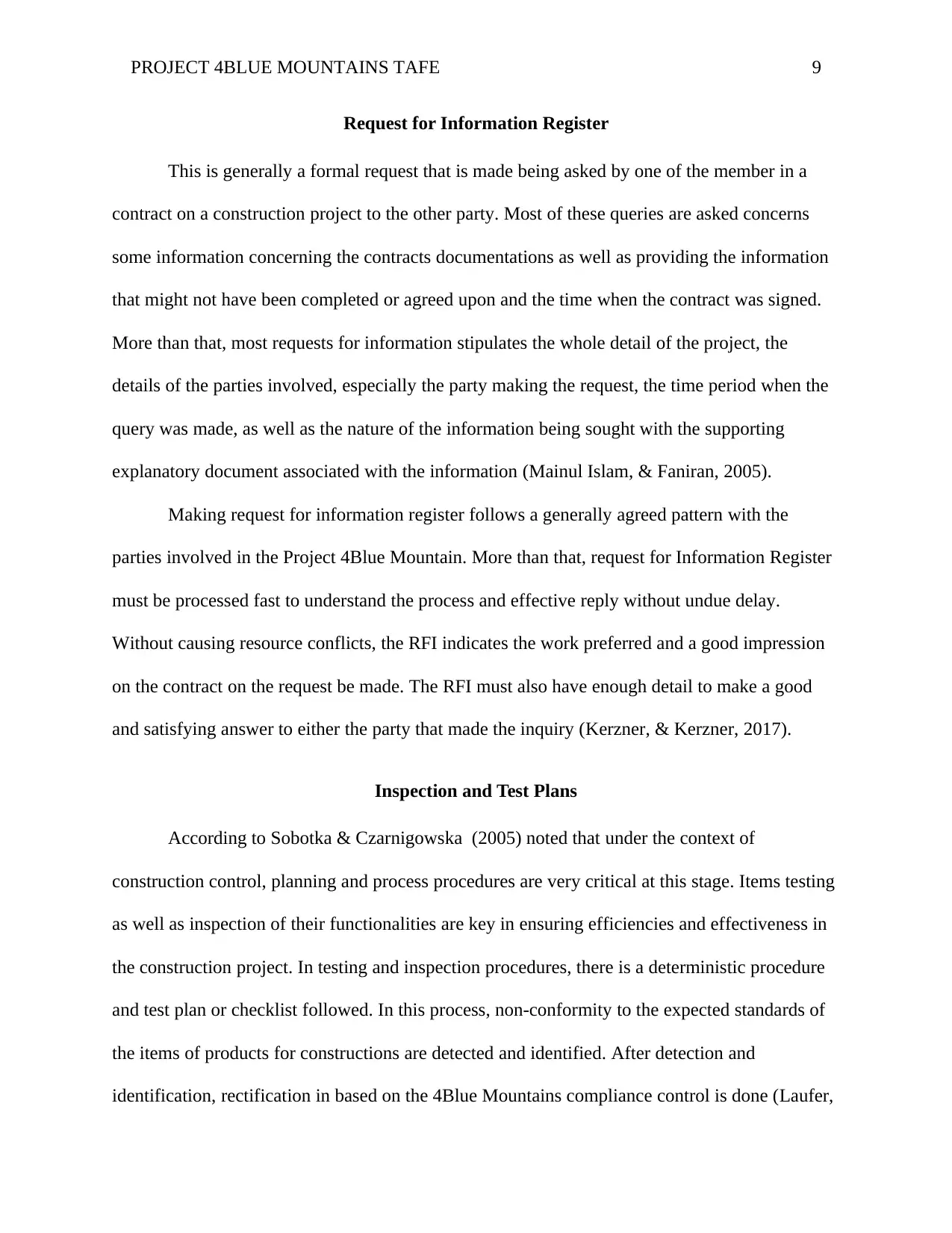
PROJECT 4BLUE MOUNTAINS TAFE 9
Request for Information Register
This is generally a formal request that is made being asked by one of the member in a
contract on a construction project to the other party. Most of these queries are asked concerns
some information concerning the contracts documentations as well as providing the information
that might not have been completed or agreed upon and the time when the contract was signed.
More than that, most requests for information stipulates the whole detail of the project, the
details of the parties involved, especially the party making the request, the time period when the
query was made, as well as the nature of the information being sought with the supporting
explanatory document associated with the information (Mainul Islam, & Faniran, 2005).
Making request for information register follows a generally agreed pattern with the
parties involved in the Project 4Blue Mountain. More than that, request for Information Register
must be processed fast to understand the process and effective reply without undue delay.
Without causing resource conflicts, the RFI indicates the work preferred and a good impression
on the contract on the request be made. The RFI must also have enough detail to make a good
and satisfying answer to either the party that made the inquiry (Kerzner, & Kerzner, 2017).
Inspection and Test Plans
According to Sobotka & Czarnigowska (2005) noted that under the context of
construction control, planning and process procedures are very critical at this stage. Items testing
as well as inspection of their functionalities are key in ensuring efficiencies and effectiveness in
the construction project. In testing and inspection procedures, there is a deterministic procedure
and test plan or checklist followed. In this process, non-conformity to the expected standards of
the items of products for constructions are detected and identified. After detection and
identification, rectification in based on the 4Blue Mountains compliance control is done (Laufer,
Request for Information Register
This is generally a formal request that is made being asked by one of the member in a
contract on a construction project to the other party. Most of these queries are asked concerns
some information concerning the contracts documentations as well as providing the information
that might not have been completed or agreed upon and the time when the contract was signed.
More than that, most requests for information stipulates the whole detail of the project, the
details of the parties involved, especially the party making the request, the time period when the
query was made, as well as the nature of the information being sought with the supporting
explanatory document associated with the information (Mainul Islam, & Faniran, 2005).
Making request for information register follows a generally agreed pattern with the
parties involved in the Project 4Blue Mountain. More than that, request for Information Register
must be processed fast to understand the process and effective reply without undue delay.
Without causing resource conflicts, the RFI indicates the work preferred and a good impression
on the contract on the request be made. The RFI must also have enough detail to make a good
and satisfying answer to either the party that made the inquiry (Kerzner, & Kerzner, 2017).
Inspection and Test Plans
According to Sobotka & Czarnigowska (2005) noted that under the context of
construction control, planning and process procedures are very critical at this stage. Items testing
as well as inspection of their functionalities are key in ensuring efficiencies and effectiveness in
the construction project. In testing and inspection procedures, there is a deterministic procedure
and test plan or checklist followed. In this process, non-conformity to the expected standards of
the items of products for constructions are detected and identified. After detection and
identification, rectification in based on the 4Blue Mountains compliance control is done (Laufer,
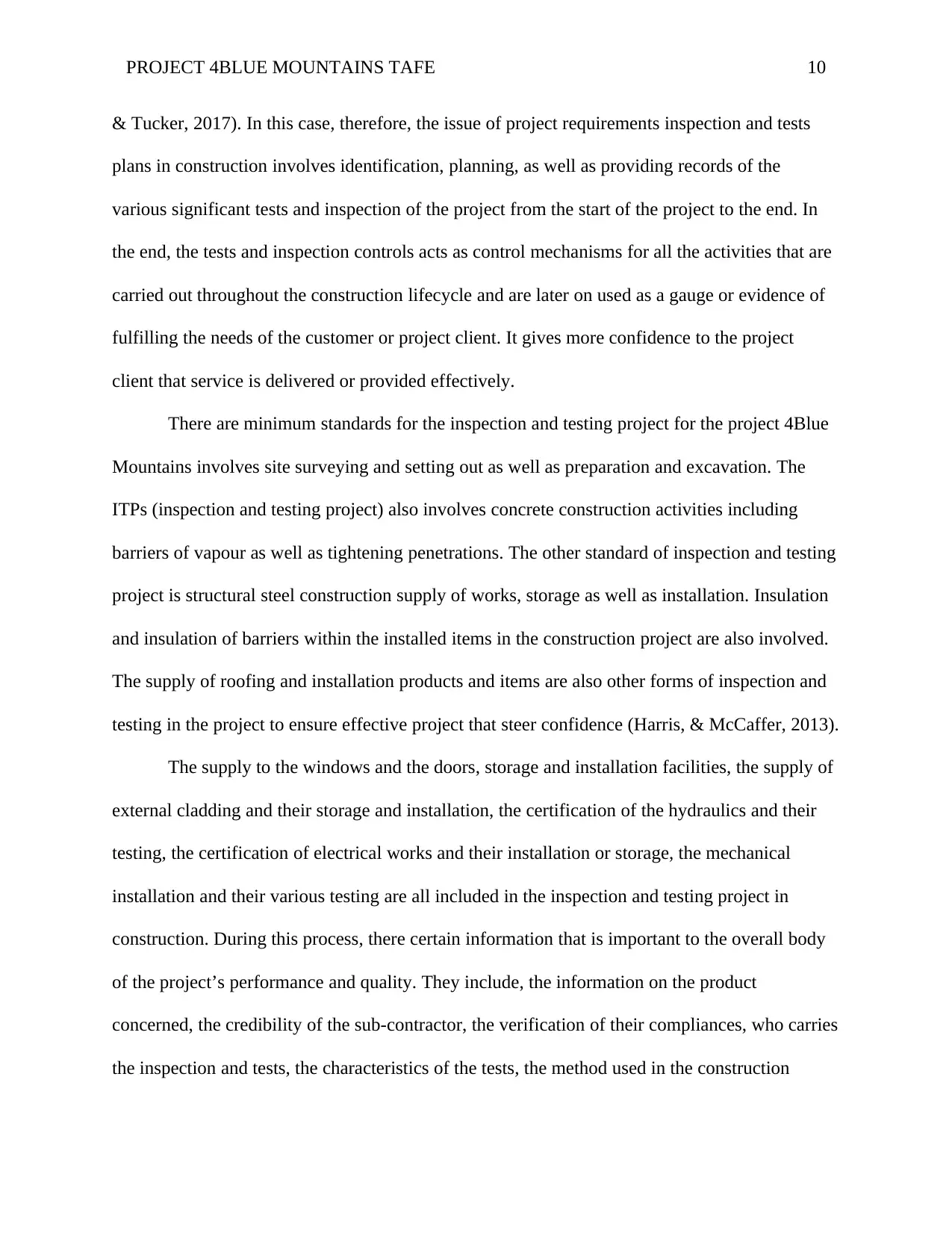
PROJECT 4BLUE MOUNTAINS TAFE 10
& Tucker, 2017). In this case, therefore, the issue of project requirements inspection and tests
plans in construction involves identification, planning, as well as providing records of the
various significant tests and inspection of the project from the start of the project to the end. In
the end, the tests and inspection controls acts as control mechanisms for all the activities that are
carried out throughout the construction lifecycle and are later on used as a gauge or evidence of
fulfilling the needs of the customer or project client. It gives more confidence to the project
client that service is delivered or provided effectively.
There are minimum standards for the inspection and testing project for the project 4Blue
Mountains involves site surveying and setting out as well as preparation and excavation. The
ITPs (inspection and testing project) also involves concrete construction activities including
barriers of vapour as well as tightening penetrations. The other standard of inspection and testing
project is structural steel construction supply of works, storage as well as installation. Insulation
and insulation of barriers within the installed items in the construction project are also involved.
The supply of roofing and installation products and items are also other forms of inspection and
testing in the project to ensure effective project that steer confidence (Harris, & McCaffer, 2013).
The supply to the windows and the doors, storage and installation facilities, the supply of
external cladding and their storage and installation, the certification of the hydraulics and their
testing, the certification of electrical works and their installation or storage, the mechanical
installation and their various testing are all included in the inspection and testing project in
construction. During this process, there certain information that is important to the overall body
of the project’s performance and quality. They include, the information on the product
concerned, the credibility of the sub-contractor, the verification of their compliances, who carries
the inspection and tests, the characteristics of the tests, the method used in the construction
& Tucker, 2017). In this case, therefore, the issue of project requirements inspection and tests
plans in construction involves identification, planning, as well as providing records of the
various significant tests and inspection of the project from the start of the project to the end. In
the end, the tests and inspection controls acts as control mechanisms for all the activities that are
carried out throughout the construction lifecycle and are later on used as a gauge or evidence of
fulfilling the needs of the customer or project client. It gives more confidence to the project
client that service is delivered or provided effectively.
There are minimum standards for the inspection and testing project for the project 4Blue
Mountains involves site surveying and setting out as well as preparation and excavation. The
ITPs (inspection and testing project) also involves concrete construction activities including
barriers of vapour as well as tightening penetrations. The other standard of inspection and testing
project is structural steel construction supply of works, storage as well as installation. Insulation
and insulation of barriers within the installed items in the construction project are also involved.
The supply of roofing and installation products and items are also other forms of inspection and
testing in the project to ensure effective project that steer confidence (Harris, & McCaffer, 2013).
The supply to the windows and the doors, storage and installation facilities, the supply of
external cladding and their storage and installation, the certification of the hydraulics and their
testing, the certification of electrical works and their installation or storage, the mechanical
installation and their various testing are all included in the inspection and testing project in
construction. During this process, there certain information that is important to the overall body
of the project’s performance and quality. They include, the information on the product
concerned, the credibility of the sub-contractor, the verification of their compliances, who carries
the inspection and tests, the characteristics of the tests, the method used in the construction
Secure Best Marks with AI Grader
Need help grading? Try our AI Grader for instant feedback on your assignments.
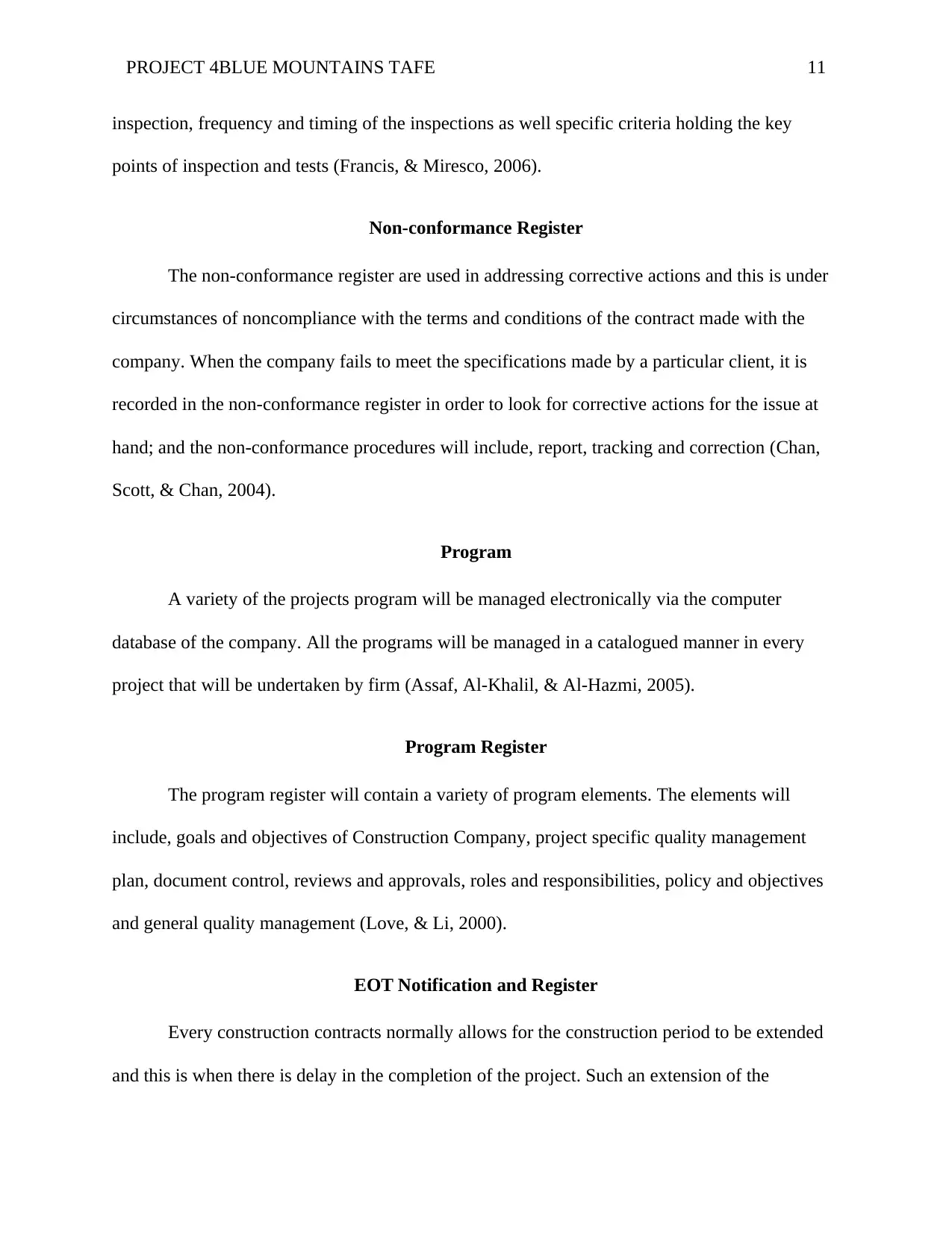
PROJECT 4BLUE MOUNTAINS TAFE 11
inspection, frequency and timing of the inspections as well specific criteria holding the key
points of inspection and tests (Francis, & Miresco, 2006).
Non-conformance Register
The non-conformance register are used in addressing corrective actions and this is under
circumstances of noncompliance with the terms and conditions of the contract made with the
company. When the company fails to meet the specifications made by a particular client, it is
recorded in the non-conformance register in order to look for corrective actions for the issue at
hand; and the non-conformance procedures will include, report, tracking and correction (Chan,
Scott, & Chan, 2004).
Program
A variety of the projects program will be managed electronically via the computer
database of the company. All the programs will be managed in a catalogued manner in every
project that will be undertaken by firm (Assaf, Al-Khalil, & Al-Hazmi, 2005).
Program Register
The program register will contain a variety of program elements. The elements will
include, goals and objectives of Construction Company, project specific quality management
plan, document control, reviews and approvals, roles and responsibilities, policy and objectives
and general quality management (Love, & Li, 2000).
EOT Notification and Register
Every construction contracts normally allows for the construction period to be extended
and this is when there is delay in the completion of the project. Such an extension of the
inspection, frequency and timing of the inspections as well specific criteria holding the key
points of inspection and tests (Francis, & Miresco, 2006).
Non-conformance Register
The non-conformance register are used in addressing corrective actions and this is under
circumstances of noncompliance with the terms and conditions of the contract made with the
company. When the company fails to meet the specifications made by a particular client, it is
recorded in the non-conformance register in order to look for corrective actions for the issue at
hand; and the non-conformance procedures will include, report, tracking and correction (Chan,
Scott, & Chan, 2004).
Program
A variety of the projects program will be managed electronically via the computer
database of the company. All the programs will be managed in a catalogued manner in every
project that will be undertaken by firm (Assaf, Al-Khalil, & Al-Hazmi, 2005).
Program Register
The program register will contain a variety of program elements. The elements will
include, goals and objectives of Construction Company, project specific quality management
plan, document control, reviews and approvals, roles and responsibilities, policy and objectives
and general quality management (Love, & Li, 2000).
EOT Notification and Register
Every construction contracts normally allows for the construction period to be extended
and this is when there is delay in the completion of the project. Such an extension of the
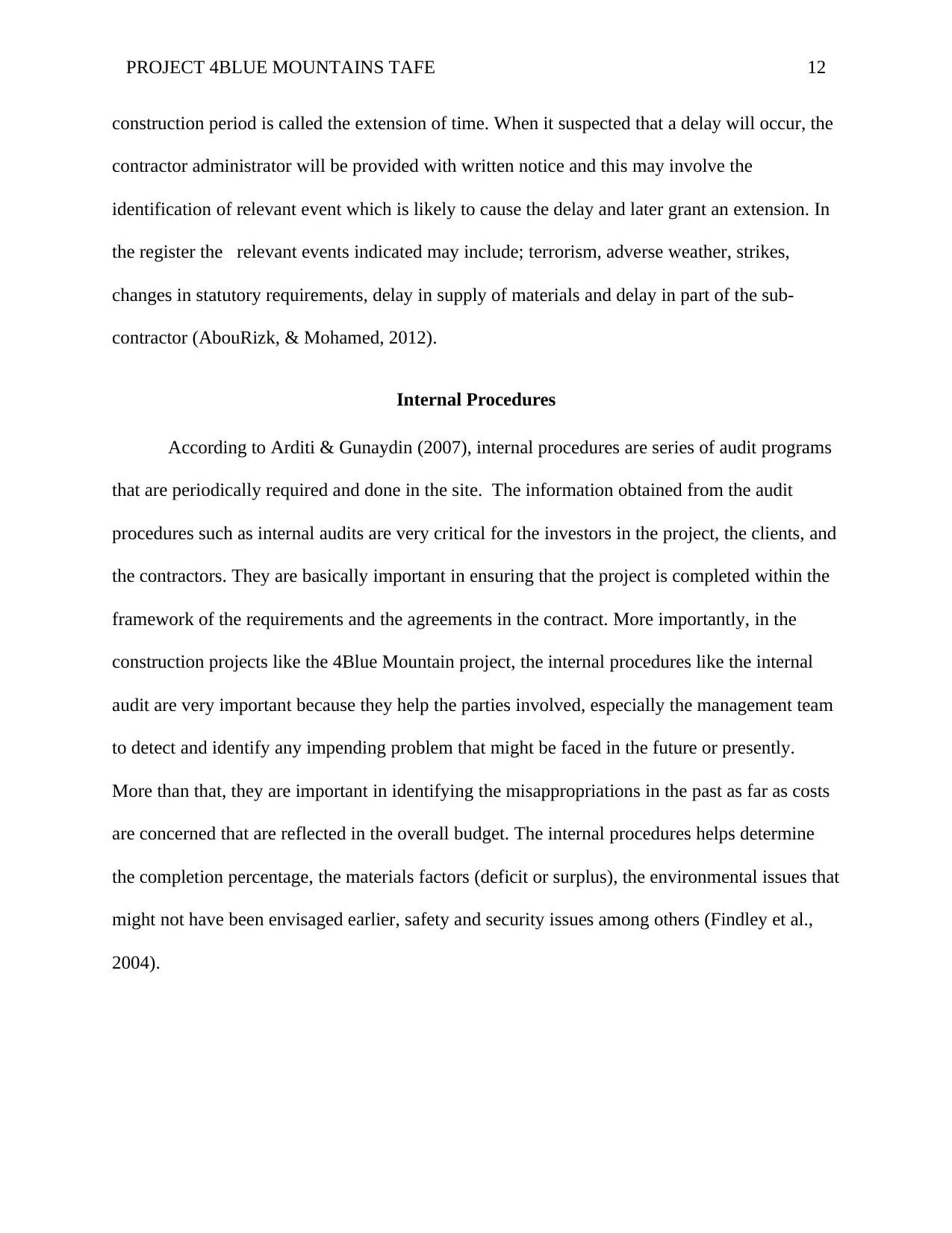
PROJECT 4BLUE MOUNTAINS TAFE 12
construction period is called the extension of time. When it suspected that a delay will occur, the
contractor administrator will be provided with written notice and this may involve the
identification of relevant event which is likely to cause the delay and later grant an extension. In
the register the relevant events indicated may include; terrorism, adverse weather, strikes,
changes in statutory requirements, delay in supply of materials and delay in part of the sub-
contractor (AbouRizk, & Mohamed, 2012).
Internal Procedures
According to Arditi & Gunaydin (2007), internal procedures are series of audit programs
that are periodically required and done in the site. The information obtained from the audit
procedures such as internal audits are very critical for the investors in the project, the clients, and
the contractors. They are basically important in ensuring that the project is completed within the
framework of the requirements and the agreements in the contract. More importantly, in the
construction projects like the 4Blue Mountain project, the internal procedures like the internal
audit are very important because they help the parties involved, especially the management team
to detect and identify any impending problem that might be faced in the future or presently.
More than that, they are important in identifying the misappropriations in the past as far as costs
are concerned that are reflected in the overall budget. The internal procedures helps determine
the completion percentage, the materials factors (deficit or surplus), the environmental issues that
might not have been envisaged earlier, safety and security issues among others (Findley et al.,
2004).
construction period is called the extension of time. When it suspected that a delay will occur, the
contractor administrator will be provided with written notice and this may involve the
identification of relevant event which is likely to cause the delay and later grant an extension. In
the register the relevant events indicated may include; terrorism, adverse weather, strikes,
changes in statutory requirements, delay in supply of materials and delay in part of the sub-
contractor (AbouRizk, & Mohamed, 2012).
Internal Procedures
According to Arditi & Gunaydin (2007), internal procedures are series of audit programs
that are periodically required and done in the site. The information obtained from the audit
procedures such as internal audits are very critical for the investors in the project, the clients, and
the contractors. They are basically important in ensuring that the project is completed within the
framework of the requirements and the agreements in the contract. More importantly, in the
construction projects like the 4Blue Mountain project, the internal procedures like the internal
audit are very important because they help the parties involved, especially the management team
to detect and identify any impending problem that might be faced in the future or presently.
More than that, they are important in identifying the misappropriations in the past as far as costs
are concerned that are reflected in the overall budget. The internal procedures helps determine
the completion percentage, the materials factors (deficit or surplus), the environmental issues that
might not have been envisaged earlier, safety and security issues among others (Findley et al.,
2004).
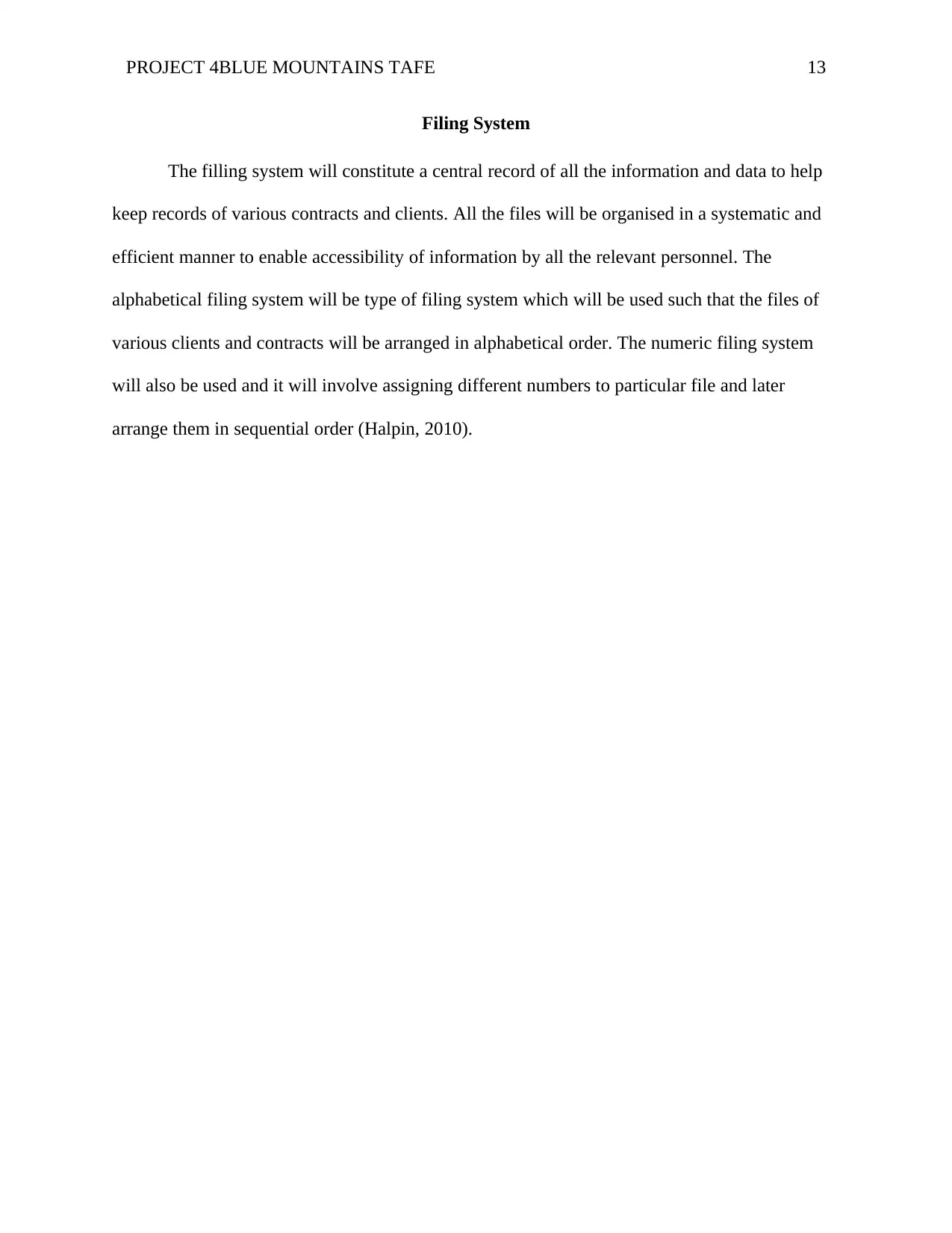
PROJECT 4BLUE MOUNTAINS TAFE 13
Filing System
The filling system will constitute a central record of all the information and data to help
keep records of various contracts and clients. All the files will be organised in a systematic and
efficient manner to enable accessibility of information by all the relevant personnel. The
alphabetical filing system will be type of filing system which will be used such that the files of
various clients and contracts will be arranged in alphabetical order. The numeric filing system
will also be used and it will involve assigning different numbers to particular file and later
arrange them in sequential order (Halpin, 2010).
Filing System
The filling system will constitute a central record of all the information and data to help
keep records of various contracts and clients. All the files will be organised in a systematic and
efficient manner to enable accessibility of information by all the relevant personnel. The
alphabetical filing system will be type of filing system which will be used such that the files of
various clients and contracts will be arranged in alphabetical order. The numeric filing system
will also be used and it will involve assigning different numbers to particular file and later
arrange them in sequential order (Halpin, 2010).
Paraphrase This Document
Need a fresh take? Get an instant paraphrase of this document with our AI Paraphraser
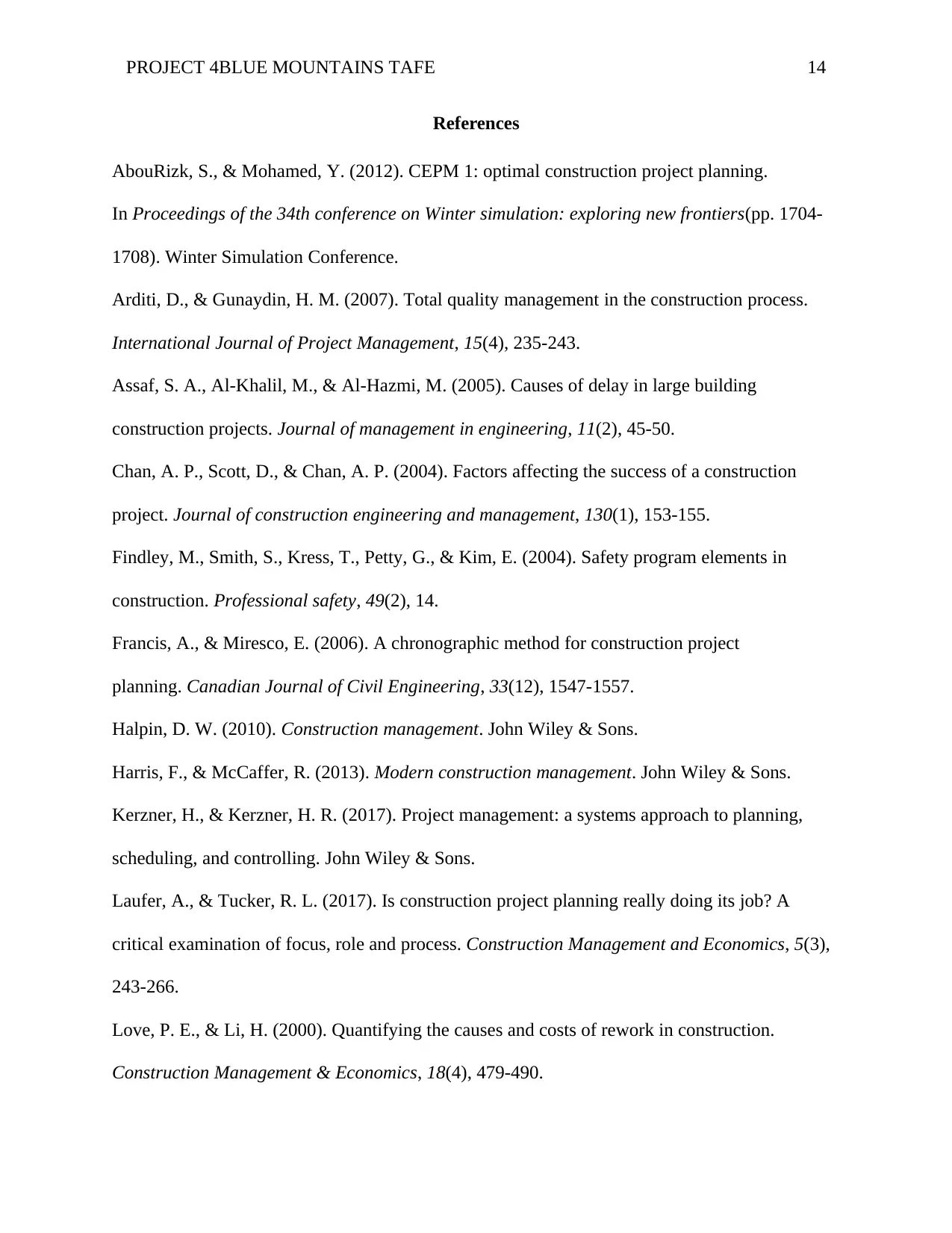
PROJECT 4BLUE MOUNTAINS TAFE 14
References
AbouRizk, S., & Mohamed, Y. (2012). CEPM 1: optimal construction project planning.
In Proceedings of the 34th conference on Winter simulation: exploring new frontiers(pp. 1704-
1708). Winter Simulation Conference.
Arditi, D., & Gunaydin, H. M. (2007). Total quality management in the construction process.
International Journal of Project Management, 15(4), 235-243.
Assaf, S. A., Al-Khalil, M., & Al-Hazmi, M. (2005). Causes of delay in large building
construction projects. Journal of management in engineering, 11(2), 45-50.
Chan, A. P., Scott, D., & Chan, A. P. (2004). Factors affecting the success of a construction
project. Journal of construction engineering and management, 130(1), 153-155.
Findley, M., Smith, S., Kress, T., Petty, G., & Kim, E. (2004). Safety program elements in
construction. Professional safety, 49(2), 14.
Francis, A., & Miresco, E. (2006). A chronographic method for construction project
planning. Canadian Journal of Civil Engineering, 33(12), 1547-1557.
Halpin, D. W. (2010). Construction management. John Wiley & Sons.
Harris, F., & McCaffer, R. (2013). Modern construction management. John Wiley & Sons.
Kerzner, H., & Kerzner, H. R. (2017). Project management: a systems approach to planning,
scheduling, and controlling. John Wiley & Sons.
Laufer, A., & Tucker, R. L. (2017). Is construction project planning really doing its job? A
critical examination of focus, role and process. Construction Management and Economics, 5(3),
243-266.
Love, P. E., & Li, H. (2000). Quantifying the causes and costs of rework in construction.
Construction Management & Economics, 18(4), 479-490.
References
AbouRizk, S., & Mohamed, Y. (2012). CEPM 1: optimal construction project planning.
In Proceedings of the 34th conference on Winter simulation: exploring new frontiers(pp. 1704-
1708). Winter Simulation Conference.
Arditi, D., & Gunaydin, H. M. (2007). Total quality management in the construction process.
International Journal of Project Management, 15(4), 235-243.
Assaf, S. A., Al-Khalil, M., & Al-Hazmi, M. (2005). Causes of delay in large building
construction projects. Journal of management in engineering, 11(2), 45-50.
Chan, A. P., Scott, D., & Chan, A. P. (2004). Factors affecting the success of a construction
project. Journal of construction engineering and management, 130(1), 153-155.
Findley, M., Smith, S., Kress, T., Petty, G., & Kim, E. (2004). Safety program elements in
construction. Professional safety, 49(2), 14.
Francis, A., & Miresco, E. (2006). A chronographic method for construction project
planning. Canadian Journal of Civil Engineering, 33(12), 1547-1557.
Halpin, D. W. (2010). Construction management. John Wiley & Sons.
Harris, F., & McCaffer, R. (2013). Modern construction management. John Wiley & Sons.
Kerzner, H., & Kerzner, H. R. (2017). Project management: a systems approach to planning,
scheduling, and controlling. John Wiley & Sons.
Laufer, A., & Tucker, R. L. (2017). Is construction project planning really doing its job? A
critical examination of focus, role and process. Construction Management and Economics, 5(3),
243-266.
Love, P. E., & Li, H. (2000). Quantifying the causes and costs of rework in construction.
Construction Management & Economics, 18(4), 479-490.
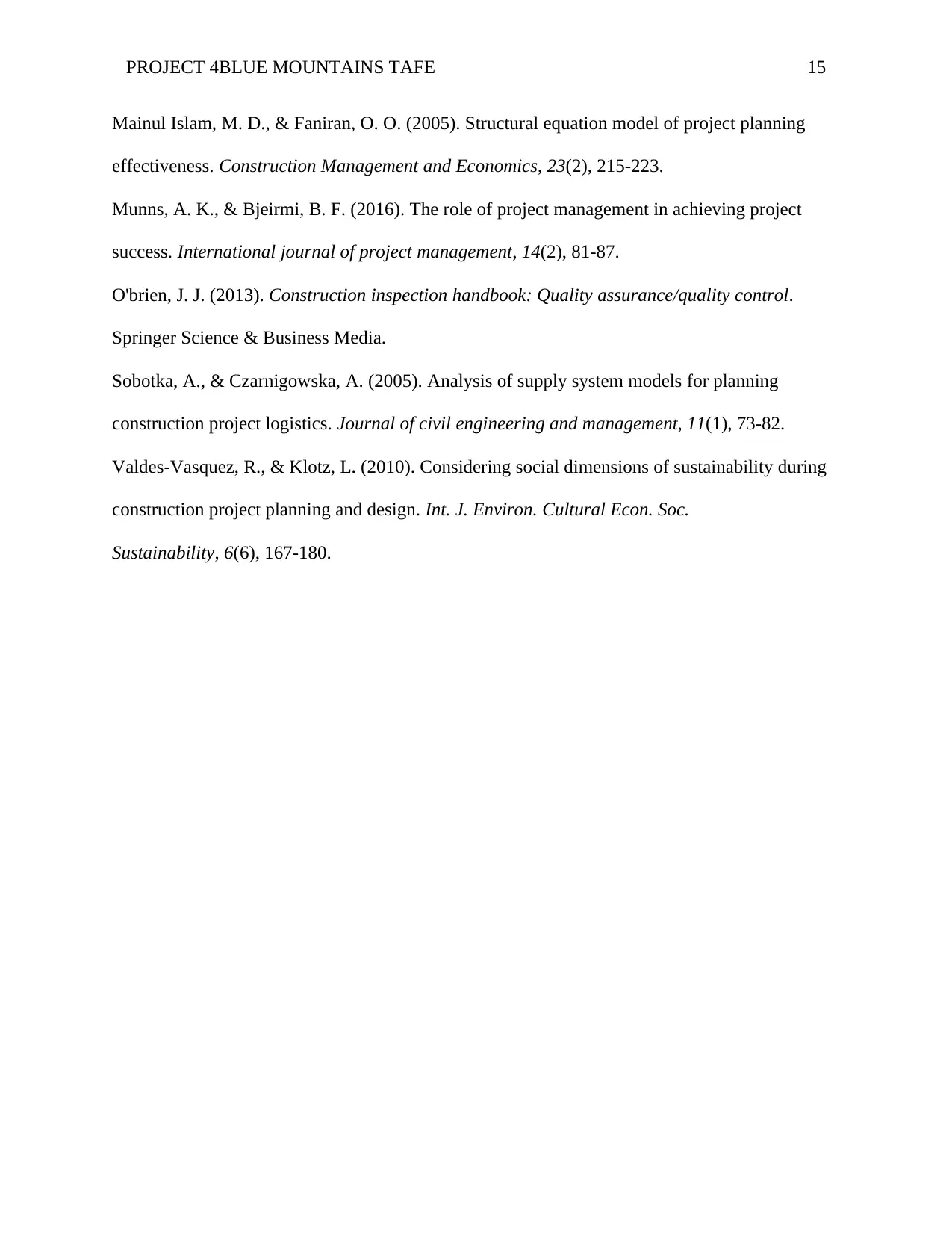
PROJECT 4BLUE MOUNTAINS TAFE 15
Mainul Islam, M. D., & Faniran, O. O. (2005). Structural equation model of project planning
effectiveness. Construction Management and Economics, 23(2), 215-223.
Munns, A. K., & Bjeirmi, B. F. (2016). The role of project management in achieving project
success. International journal of project management, 14(2), 81-87.
O'brien, J. J. (2013). Construction inspection handbook: Quality assurance/quality control.
Springer Science & Business Media.
Sobotka, A., & Czarnigowska, A. (2005). Analysis of supply system models for planning
construction project logistics. Journal of civil engineering and management, 11(1), 73-82.
Valdes-Vasquez, R., & Klotz, L. (2010). Considering social dimensions of sustainability during
construction project planning and design. Int. J. Environ. Cultural Econ. Soc.
Sustainability, 6(6), 167-180.
Mainul Islam, M. D., & Faniran, O. O. (2005). Structural equation model of project planning
effectiveness. Construction Management and Economics, 23(2), 215-223.
Munns, A. K., & Bjeirmi, B. F. (2016). The role of project management in achieving project
success. International journal of project management, 14(2), 81-87.
O'brien, J. J. (2013). Construction inspection handbook: Quality assurance/quality control.
Springer Science & Business Media.
Sobotka, A., & Czarnigowska, A. (2005). Analysis of supply system models for planning
construction project logistics. Journal of civil engineering and management, 11(1), 73-82.
Valdes-Vasquez, R., & Klotz, L. (2010). Considering social dimensions of sustainability during
construction project planning and design. Int. J. Environ. Cultural Econ. Soc.
Sustainability, 6(6), 167-180.
1 out of 15
Related Documents
Your All-in-One AI-Powered Toolkit for Academic Success.
+13062052269
info@desklib.com
Available 24*7 on WhatsApp / Email
![[object Object]](/_next/static/media/star-bottom.7253800d.svg)
Unlock your academic potential
© 2024 | Zucol Services PVT LTD | All rights reserved.



